[Press Release]
A team of scientists determined the origin and evolution of carbonaceous asteroid Ryugu through sample analysis and computer simulations.
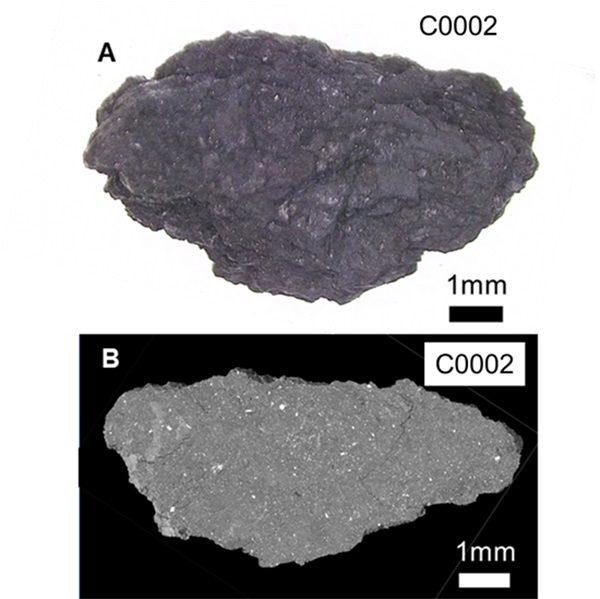
A team of scientists determined the origin and evolution of carbonaceous asteroid Ryugu through sample analysis and computer simulations. The analysis of 17 particles included the third largest sample by the ‘Hayabusa2 Initial Analysis Team’ consisting of scientists from several universities and research institutes in Japan, including the Earth-Life Science Institute (ELSI) at Tokyo Institute of Technology.
The research team found that Ryugu samples contain particles such as calcium–aluminium-rich inclusion (CAI) – the oldest solid particles in the solar system – that were formed in high-temperature environments around >1000°C. These high-temperature particles are thought to have formed near the Sun and then migrated to the outer Solar System, where the asteroid Ryugu was formed. This indicates that large-scale mixing of materials occurred between the inner and outer solar system at the time of its birth.
Based on the detection of the magnetic field left in the Ryugu samples, it is highly likely that the original asteroid (Ryugy’s parent body) from which the current Ryugu descended was formed in the primordial solar nebula – which does not exist today – in the darkness of nebular gas far from the Sun, where sunlight cannot reach. Not only water ice but also dry ice (CO2 ice) existed in the region where Ryguy’s parent body was formed and at an extremely low temperature of -200oC or lower.
The research team discovered liquid water trapped in a crystal in the sample. This water was carbonated water containing salts and organic matter, which was once present in the Ryugu parent body. Crystals shaped like coral reefs were growing from the liquid water that existed in the interior of Ryugu’s parent body. In the parent body of Ryugu, the water-to-rock ratio differed between the surface and the interior, with rocks deeper underground containing more water. In the interior of Ryugu’s parent body, tabular coral-like crystals grew from liquid water, suggesting that an environment similar to the Earth’s oceans existed in Ryugu’s interior.
It was determined by measuring the Ryugu samples’ hardness, heat transfer, and magnetic properties that the Rygyu sample was soft enough to be cut with a knife. The hardness is very low compared to igneous rocks on Earth, making them soft. The samples were precisely determined by synchrotron radiation CT analysis with a spatial resolution of less than 1 micron, and the mass was measured in an environment with no atmosphere to avoid the influence of adsorbed water on the samples. The average density of the sample was 1.79 ± 0.08 g/cm3, which is much higher than the density of the entire Ryugu asteroid (1.19 g/cm3). This suggests that the interior of Ryugu contains more than 30% of pore spaces.
The sample also contained many small magnets, behaving like a natural hard disk, recording the magnetic field of the past. This structure is more stable than ordinary hard disks and can record more than 4.6 billion years of magnetic fields. The magnetic fields inside and around magnetite record the magnetic field at the time when these crystals were formed, and it is highly likely that the solar nebula (with a magnetic field) was present when the Ryugu parent body was formed.
The research team successfully reproduced the history of Ryugu, from the birth of the parent body to the disruption of the parent body via a large-scale collision using a computer. This is the first time that the results of hardness and thermal diffusivity of an actual asteroid sample are used to simulate the formation and evolution of an asteroid.
The simulations of the collisional destruction of the parent body of Ryugu show the size of the impactor that destroyed the Ryugu parent body, which is about 100 km in diameter, is at most 10 km in diameter, and that the present-day Ryugu is composed of material from a region far from the impact point. It is thought that Ryugu once belonged to either the Polarna or Eularia family of asteroid families and that all asteroids belonging to these families were formed by the destruction of Ryugu’s parent body.
“From these simulations, we found that the Ryugu parent body was formed about 2 million years after the first solid was condensed in the Solar System and then heated up to about 50°C over the next 3 million years, resulting in chemical reactions between water and rock,” said Hidenori Genda, Professor at ELSI. Genda coordinated all simulations about the origin and evolution of the Ryugu parent body and added that “the asteroid Ryugu was formed from the central part or far side of the impact site in Ryugu parent body during a disruptive collision.”
Water-bearing asteroids such as Ryugu are more widely distributed in the Solar System than water-free objects. This study shows how such asteroids formed, evolved, and were collisionally destroyed to their present form in the low-temperature region outside Jupiter, far from the Sun. This has provided a pathway to solutions to some of the many unresolved questions regarding the formation of the Solar System.
EDITOR: This text was adapted from the Joint Press Release by Japan Aerospace Exploration Agency (JAXA).
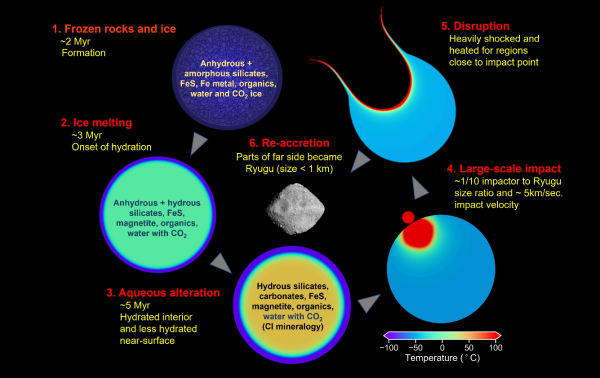
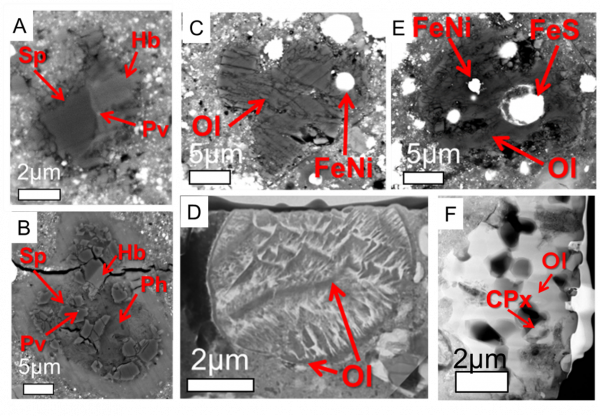
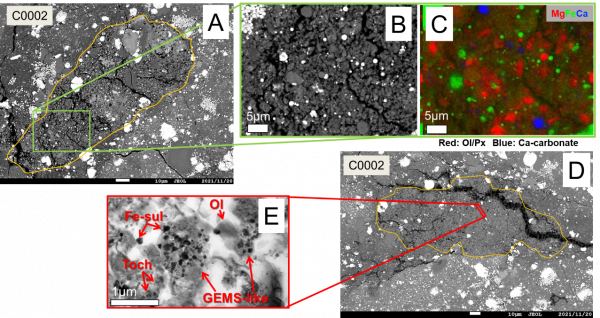
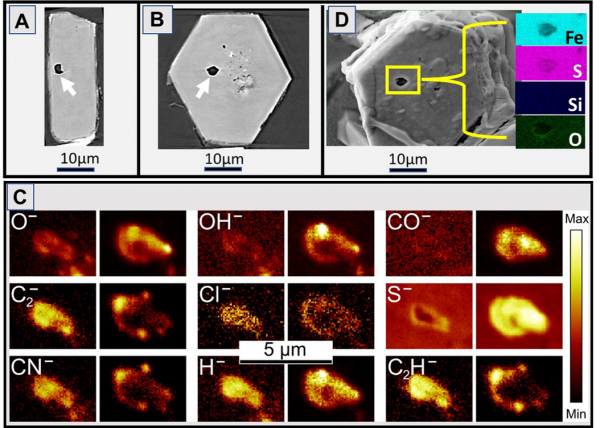
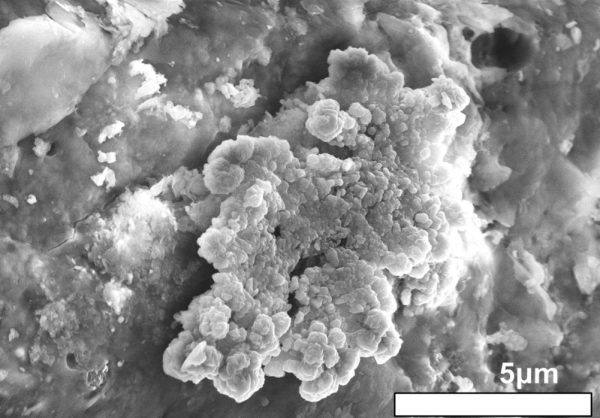
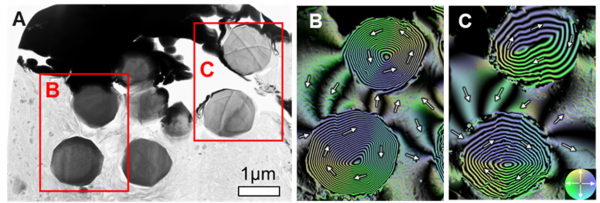
Reference
Nakamura1, M. Matsumoto1, K. Amano1, Y. Enokido1, M. E. Zolensky2, T. Mikouchi3, H. Genda4, S. Tanaka5,6, M. Y. Zolotov7, K. Kurosawa8, S. Wakita9, R. Hyodo5, H. Nagano10, D. Nakashima1, Y. Takahashi11,12, Y. Fujioka1, M. Kikuiri1, E. Kagawa1, M. Matsuoka13,14, A. J. Brearley15, A. Tsuchiyama16,17,18, M. Uesugi19, J. Matsuno16, Y. Kimura20, M. Sato11, R. E. Milliken21, E. Tatsumi22,11, S. Sugita11,8, T. Hiroi21, K. Kitazato23, D. Brownlee24, D. J. Joswiak24, M. Takahashi1, K. Ninomiya25, T. Takahashi26,27, T. Osawa28, K. Terada29, F. E. Brenker30, B. J. Tkalcec30, L. Vincze31, R. Brunetto32, A. Aléon-Toppani32, Q. H. S. Chan33, M. Roskosz34, J.-C. Viennet34, P. Beck35, E. E. Alp36, T. Michikami37, Y. Nagaashi38,1, T. Tsuji39,40, Y. Ino41,5, J. Martinez2, J. Han42, A. Dolocan43, R. J. Bodnar44, M. Tanaka45, H. Yoshida11, K. Sugiyama46, A. J. King47, K. Fukushi48, H. Suga49, S. Yamashita50,51, T. Kawai11, K. Inoue48, A. Nakato5, T. Noguchi52,53, F. Vilas54, A. R. Hendrix54, C. Jaramillo-Correa55, D. L. Domingue54, G. Dominguez56, Z. Gainsforth57, C. Engrand58, J. Duprat34, S. S. Russell47, E. Bonato59, C. Ma60, T. Kawamoto61, T. Wada1, S. Watanabe5,26, R. Endo62, S. Enju63, L. Riu64, S. Rubino32, P. Tack31, S. Takeshita65, Y. Takeichi50,51,66, A. Takeuchi19, A. Takigawa11, D. Takir2, T. Tanigaki67, A. Taniguchi68, K. Tsukamoto1, T. Yagi69, S. Yamada70, K. Yamamoto71, Y. Yamashita69, M. Yasutake19, K. Uesugi19, I. Umegaki72,65, I. Chiu25, T. Ishizaki5, S. Okumura52, E. Palomba73, C. Pilorget32,74, S. M. Potin13,75, A. Alasli10, S. Anada71, Y. Araki76, N. Sakatani70,5, C. Schultz21, O. Sekizawa49, S. D. Sitzman77, K. Sugiura4, M. Sun17,18,78, E. Dartois79, E. De Pauw31, Z. Dionnet32, Z. Djouadi32, G. Falkenberg80, R. Fujita10, T. Fukuma81, I. R. Gearba43, K. Hagiya82, M. Y. Hu36, T. Kato71, T. Kawamura83, M. Kimura50,51, M. K. Kubo84, F. Langenhorst85, C. Lantz32, B. Lavina86 , M. Lindner30, J. Zhao36, B. Vekemans31, D. Baklouti32, B. Bazi31, F. Borondics87, S. Nagasawa26, 27, G. Nishiyama11, K. Nitta49, J. Mathurin88, T. Matsumoto52, I. Mitsukawa52, H. Miura89, A. Miyake52, Y. Miyake65, H. Yurimoto90, R. Okazaki91, H. Yabuta92, H. Naraoka91, K. Sakamoto5, S. Tachibana11,5, H. C. Connolly Jr.93, D. S. Lauretta94, M. Yoshitake5, M. Yoshikawa5,6, K. Yoshikawa95, K. Yoshihara5, Y. Yokota5, K. Yogata5, H. Yano5,6, Y. Yamamoto5,6, D. Yamamoto5, M. Yamada8, T. Yamada5, T. Yada5, K. Wada8, T. Usui5,11, R. Tsukizaki5, F. Terui96, H. Takeuchi5,6, Y. Takei5, A. Iwamae97, H. Soejima5,97, K. Shirai5, Y. Shimaki5, H. Senshu8, H. Sawada5, T. Saiki5, M. Ozaki5,6, G. Ono95 T. Okada5,98, N. Ogawa5, K. Ogawa5, R. Noguchi99, H. Noda100, M. Nishimura5, N. Namiki100,6, S. Nakazawa5, T. Morota11, A. Miyazaki5, A. Miura5, Y. Mimasu5, K. Matsumoto100,6, K. Kumagai5,97, T. Kouyama101, S. Kikuchi8,100, K. Kawahara5, S. Kameda70,5, T. Iwata5,6, Y. Ishihara102, M. Ishiguro103, H. Ikeda95, S. Hosoda5, R. Honda104,105, C. Honda23, Y. Hitomi5,97, N. Hirata38, N. Hirata23, T. Hayashi5, M. Hayakawa5, K. Hatakeda5,97, S. Furuya11, R. Fukai5, A. Fujii5, Y. Cho11, M. Arakawa38, M. Abe5,6, S. Watanabe106, Y. Tsuda5, Formation and evolution of carbonaceous asteroid Ryugu: Direct evidence from returned samples, Science, DOI: 10.1126/science.abn8671
- Department of Earth Sciences, Tohoku University, Sendai 980-8578, Japan.
- NASA Johnson Space Center; Houston TX 77058, USA.
- The University Museum, The University of Tokyo, Tokyo 113-0033, Japan.
- Earth-Life Science Institute, Tokyo Institute of Technology, Tokyo 152-8550, Japan.
- Institute of Space and Astronautical Science, Japan Aerospace Exploration Agency (JAXA), Sagamihara 252-5210, Japan.
- Department of Space and Astronautical Science, The Graduate University for Advanced Studies (SOKENDAI), Hayama 240-0193, Japan.
- School of Earth and Space Exploration, Arizona State University, Tempe AZ 85287, USA.
- Planetary Exploration Research Center, Chiba Institute of Technology, Narashino 275-0016, Japan.
- Department of Earth, Atmospheric and Planetary Sciences, Massachusetts Institute of Technology, Cambridge MA 02139, USA.
- Department of Mechanical Systems Engineering, Nagoya University, Nagoya 464-8603, Japan.
- Department of Earth and Planetary Science, The University of Tokyo, Tokyo 113-0033, Japan.
- Isotope Science Center, The University of Tokyo, Tokyo 113-0032, Japan
- Laboratoire d’Etudes Spatiales et d’Instrumentation en Astrophysique (LESIA), Observatoire de Paris, Meudon 92195 France
- Geological Survey of Japan, National Institute of Advanced Industrial Science and Technology (AIST), Tsukuba, 305-8567, Japan.
- Department of Earth and Planetary Sciences, University of New Mexico, Albuquerque NM 87131, USA.
- Research Organization of Science and Technology, Ritsumeikan University, Kusatsu 525-8577, Japan.
- Chinese Academy of Sciences (CAS) Key Laboratory of Mineralogy and Metallogeny, Guangdong Provincial Key Laboratory of Mineral Physics and Materials, Guangzhou Institute of Geochemistry, CAS, Guangzhou 510640, China.
- CAS Center for Excellence in Deep Earth Science, Guangzhou 510640, China.
- Scattering and Imaging Division, Japan Synchrotron Radiation Research Institute, Sayo 679-5198, Japan.
- Institute of Low Temperature Science, Hokkaido University, Sapporo 060-0819, Japan.
- Department of Earth, Environmental, and Planetary Sciences, Brown University, Providence, RI 02912, USA.
- Instituto de Astrofísica de Canarias, University of La Laguna, Tenerife 38205, Spain.
- Aizu Research Center for Space Informatics, The University of Aizu, Aizu-Wakamatsu 965-8580, Japan.
- Department of Astronomy, University of Washington, Seattle WA 98195 USA.
- Institute for Radiation Sciences, Osaka University, Toyonaka 560-0043, Japan.
- Kavli Institute for the Physics and Mathematics of the Universe (The World Premier International Research Center Initiative), The University of Tokyo, Kashiwa 277-8583, Japan.
- Department of Physics, The University of Tokyo, Tokyo 113-0033, Japan.
- Materials Sciences Research Center, Japan Atomic Energy Agency, Tokai 319-1195, Japan.
- Department of Earth and Space Science, Osaka University; Toyonaka 560-0043, Japan.
- Institute of Geoscience, Goethe University, Frankfurt, 60438 Frankfurt am Main, Germany.
- Department of Chemistry, Ghent University, Krijgslaan 281 S12, Ghent, Belgium.
- Institut d’Astrophysique Spatiale, Université Paris-Saclay, Orsay 91405, France.
- Department of Earth Sciences, Royal Holloway University of London, Egham TW20 0EX, UK.
- 34. Institut de Minéralogie, Physique des Matériaux et Cosmochimie, Muséum National d’Histoire Naturelle, Centre national de la recherche scientifique (CNRS), Sorbonne Université, Paris, France.
- Institut de Planétologie et d’Astrophysique de Grenoble, CNRS, Université Grenoble Alpes, 38000 Grenoble, France.
- Advanced Photon Source, Argonne National Laboratory, Argonne, IL 60439, USA.
- Faculty of Engineering, Kindai University, Higashi-Hiroshima 739-2116, Japan.
- Department of Planetology, Kobe University, Kobe 657-8501, Japan.
- Department of Earth Resources Engineering, Kyushu University, Fukuoka 819-0395, Japan.
- School of Engineering, The University of Tokyo, Tokyo 113-0033, Japan.
- Department of Physics, Kwansei Gakuin University, Sanda 669-1330, Japan.
- Department of Earth and Atmospheric Sciences, University of Houston, Houston TX 77204, USA.
- Texas Materials Institute, The University of Texas at Austin, Austin TX 78712, USA.
- Department of Geoscience, Virginia Tech., Blacksburg VA 24061, USA.
- Materials Analysis Station, National Institute for Materials Science, Tsukuba 305-0047, Japan.
- Institute for Materials Research, Tohoku University, Sendai 980-8577, Japan.
- Department of Earth Science, Natural History Museum, London SW7 5BD, UK.
- Institute of Nature and Environmental Technology, Kanazawa University, Kanazawa 920-1192, Japan.
- Spectroscopy Division, Japan Synchrotron Radiation Research Institute, Sayo 679-5198, Japan.
- Department of Materials Structure Science, The Graduate University for Advanced Studies (SOKENDAI), Tsukuba, Ibaraki 305-0801, Japan.
- Institute of Materials Structure Science, High-Energy Accelerator Research Organization, Tsukuba 305-0801, Japan.
- Division of Earth and Planetary Sciences, Kyoto University; Kyoto 606-8502, Japan
- Faculty of Arts and Science, Kyushu University, Fukuoka 819-0395, Japan.
- Planetary Science Institute, Tucson AZ 85719, USA.
- The Pennsylvania State University, University Park, PA 16802, USA.
- Department of Physics, California State University, San Marcos, CA 92096, USA.
- Space Sciences Laboratory, University of California, Berkeley, California 94720, USA.
- 58. Laboratoire de Physique des 2 Infinis Irène Joliot-Curie, Université Paris-Saclay, CNRS, 91405 Orsay, France.
- Institute for Planetary Research, Deutsches Zentrum für Luftund Raumfahrt, Rutherfordstraße 2 12489 Berlin, Germany.
- Division of Geological and Planetary Sciences, California Institute of Technology, Pasadena CA 91125, USA.
- Department of Geosciences, Shizuoka University, Shizuoka 422-8529, Japan.
- Department of Materials Science and Engineering, Tokyo Institute of Technology, Tokyo 152-8550, Japan.
- Graduate School of Science and Engineering, Ehime University, Matsuyama 790-8577, Japan.
- European Space Astronomy Centre, 28692 Villanueva de la Cañada, Spain.
- High Energy Accelerator Research Organization, Tokai 319-1106, Japan.
- Department of Applied Physics, Osaka University, Suita, 565-0871, Japan
- Hitachi, Ltd., Hatoyama 350-0395, Japan.
- Institute for Integrated Radiation and Nuclear Science, Kyoto University, Kumatori 590-0494, Japan.
- National Metrology Institute of Japan, AIST, Tsukuba 305-8565, Japan.
- Department of Physics, Rikkyo University, Tokyo 171-8501, Japan.
- Japan Fine Ceramics Center, Nagoya 456-8587, Japan.
- Toyota Central Research and Development Laboratories, Inc., Nagakute 480-1192, Japan.
- 73. Istituto di Astrofisica e Planetologia Spaziali, Istituto Nazionale di Astrofisica, Rome 00133, Italy.
- Institut Universitaire de France, Paris, France.
- Faculty of Aerospace Engineering, Delft University of Technology, Delft, The Netherlands
- Department of Physical Sciences, Ritsumeikan University, Shiga 525-0058, Japan.
- Physical Sciences Laboratory, The Aerospace Corporation, California 90245, USA.
- University of Chinese Academy of Sciences, Beijing 100049, China.
- Institut des Sciences Moléculaires d’Orsay, Université Paris-Saclay, CNRS, 91405 Orsay, France.
- Deutsches Elektronen-Synchrotron Photon Science, 22603 Hamburg, Germany.
- Nano Life Science Institute (The World Premier International Research Center Initiative), Kanazawa University, 920-1192, Japan.
- Graduate School of Life Science, University of Hyogo, Hyogo 678-1297, Japan.
- Institut de Physique du Globe de Paris, Université de Paris, Paris 75205, France.
- Division of Natural Sciences, International Christian University, Mitaka 181-8585, Japan.
- Institute of Geosciences, Friedrich-Schiller-Universität Jena, 07745 Jena, Germany.
- Center for Advanced Radiation Sources, The University of Chicago, Chicago, IL 60637, USA.
- Optimized Light Source of Intermediate Energy to LURE (SOLEIL) Synchrotron, L’Orme des Merisiers, Gif sur Yvette Cedex, F-91192, France.
- Institut Chimie Physique, Université Paris-Saclay, CNRS, 91405 Orsay, France.
- Graduate School of Science, Nagoya City University, Nagoya 467-8501, Japan.
- Department of Natural History Sciences, Hokkaido University, Sapporo 060-0810, Japan.
- Department of Earth and Planetary Sciences, Kyushu University, Fukuoka 819-0395, Japan.
- Graduate School of Advanced Science and Engineering, Hiroshima University, Higashi-Hiroshima 739-8526, Japan.
- Department of Geology, Rowan University, Glassboro NJ 08028, USA.
- Lunar and Planetary Laboratory, University of Arizona; Tucson AZ 85721, USA.
- Research and Development Directorate, JAXA, Sagamihara 252-5210, Japan.
- Department of Mechanical Engineering, Kanagawa Institute of Technology, Atsugi 243-0292, Japan.
- Marine Works Japan Ltd., Yokosuka 237-0063 Japan.
- Department of Chemistry, The University of Tokyo, Tokyo 113-0033, Japan.
- Faculty of Science, Niigata University, Niigata 950-2181, Japan.
- National Astronomical Observatory of Japan, Mitaka 181-8588, Japan.
- Digital Architecture Research Center, National Institute of Advanced Industrial Science and Technology, Tokyo 135-0064, Japan.
- JAXA Space Exploration Center, JAXA, Sagamihara 252-5210, Japan.
- Department of Physics and Astronomy, Seoul National University, Seoul 08826, Korea.
- Department of Information Science, Kochi University, Kochi 780-8520, Japan
- Center for Data Science, Ehime University, Matsuyama 790-8577, Japan.
- Department of Earth and Environmental Sciences, Nagoya University, Nagoya 464-8601, Japan.
Contacts:
Thilina Heenatigala
Director of Communications
Earth-Life Science Institute (ELSI),
Tokyo Institute of Technology
E-mail: thilinah@elsi.jp
Tel: +81-3-5734-3163
Hidenoti Genda
Profesor
Earth-Life Science Institute (ELSI),
Tokyo Institute of Technology
E-mail: genda@elsi.jp
Tel: 03-5734-3289
